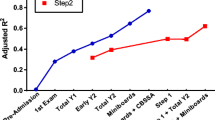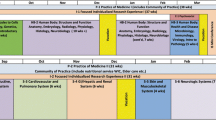Abstract
Medical schools employ a variety of preadmission measures to select students most likely to succeed in the program. The Medical College Admission Test (MCAT) and the undergraduate college grade point average (uGPA) are two academic measures typically used to select students in medical school. The assumption that presently used preadmission measures can predict clinical skill performance on a medical licensure examination was evaluated within a validity argument framework (Kane 1992). A hierarchical generalized linear model tested relationships between the log-odds of failing a high-stakes medical licensure performance examination and matriculant academic and non-academic preadmission measures, controlling for student-and school-variables. Data includes 3,189 matriculants from 22 osteopathic medical schools tested in 2009–2010. Unconditional unit-specific model expected average log-odds of failing the examination across medical schools is −3.05 (se = 0.11) or 5%. Student-level estimated coefficients for MCAT Verbal Reasoning scores (0.03), Physical Sciences scores (0.05), Biological Sciences scores (0.04), uGPAscience (0.07), and uGPAnon-science (0.26) lacked association with the log-odds of failing the COMLEX-USA Level 2-PE, controlling for all other predictors in the model. Evidence from this study shows that present preadmission measures of academic ability are not related to later clinical skill performance. Given that clinical skill performance is an important part of medical practice, selection measures should be developed to identify students who will be successful in communication and be able to demonstrate the ability to systematically collect a medical history, perform a physical examination, and synthesize this information to diagnose and manage patient conditions.
Similar content being viewed by others
References
Accreditation Council for Graduate Medical Education. (2005). The ACGME outcome project: An introduction (pp. 1–39). Retrieved from https://www.acgme.org/outcome/project/OPintrorev1_7-05.ppt.
Agresti, A. (1996). An introduction to categorical data analysis. New York: Wiley.
Albanese, M. A., Snow, M. H., Skochelak, S. E., Huggett, K. N., & Farrell, P. M. (2003). Assessing personal qualities in medical school admissions. Academic Medicine, 78(3), 313–321.
American Educational Research Association, American Psychological Association, & National Council on Measurement in Education. (1999). Standards for educational and psychological testing. Washington, DC: American Educational Research Association.
Baker, H. H., Cope, M. K., Adelman, M. D., Schuler, S., Foster, R. W., & Gimpel, J. R. (2006). Relationships between scores on the COMLEX-USA Level 2-Peformance Evaluation and selected school-based performance measures. The Journal of the American Osteopathic Association, 106(5), 290–295.
Boulet, J. R., Smee, S. M., Dillon, G. F., & Gimpel, J. R. (2009). The use of standardized patient assessments for certification and licensure decisions. Simulation in Health Care, 4(1), 35–42.
Commission on Osteopathic College Accreditation. (2011). Accreditation of colleges of osteopathic medicine: COM accreditation standards and proceedures (pp. 1–85). Chicago, IL: American Osteopathic Association.
Cronbach, L. J. (1989). Construct validation after thirty years. In R. L. Linn (Ed.), Intelligence: Measurement, theory, and public policy (pp. 147–171). Urbana, IL: Univerisity of Illinois Press.
Cuddy, M. M., Swanson, D. B., & Clauser, B. E. (2007). A multilevel analysis of the relationsips between examinee gender and United States medical licensing exam (USMLE) Step 2 CK content area perfomrance. Academic Medicine, 82(10), 89–93.
Donnon, T., Oddone, E., & Violato, C. (2007). The predictive validity of the MCAT for medical school performance and medical board licensing examinations: A meta-analysis of published research. Academic Medicine, 82(1), 100–106.
Eva, K. W., & Reiter, H. I. (2004). Where judgement fails: pitfalls in the selection process for medical personnel. Advances in Health Sciences Education, 9(2), 161–174. doi:10.1023/B:AHSE.0000027479.14637.6c.
Eva, K. W., Reiter, H. I., Rosenfeld, J., & Norman, G. (2004a). The relationship between interviewer characteristics and ratings assigned during a multiple mini-interview. Academic Medicine, 79, 602–608.
Eva, K. W., Reiter, H. I., Trinh, K., Wasi, P., Rosenfeld, J., & Norman, G. R. (2009). Predictive validity of the multiple mini-interview for selecting medical trainees. Medical Education, 43, 767–775. doi:10.1111/j.1365-2923.2009.03407.x.
Eva, K. W., Rosenfeld, J., Reiter, H. I., & Norman, G. R. (2004b). An admissions OSCE: The multiple mini-interview. Medical Education, 38(3), 314–326. doi:10.1046/j.1365-2923.2004.01776.x.
Gimpel, J. R., Boulet, J. R., & Weidner, A. C. (2006). Survey on the clinical skills of osteopathic medical students. The Journal of the American Osteopathic Association, 106, 296–301.
Hamdy, H., Prasad, K., Brownell, A. M., Scherpbier, A., Williams, R., Zwierstra, R., et al. (2006). BEME systematic review: Predictive values of measurements obtained in medical schools and future performance in medical practice. Medical Teacher, 28(2), 103–116. doi:10.1080/01421590600622723.
Kane, M. T. (1992). An argument-based approach to validity. Psychological Bulletin, 112(3), 527–535.
Kane, M. (2004). Certification testing as an illustration of argument-based validation. Measurement Interdisciplinary Research and Perspectives, 2(3), 135–170.
Kane, M., Crooks, T., & Cohen, A. (1999). Validating measures of performance. Educational Measurement Issues and Practice, 18(2), 5–17. doi:10.1111/j.1745-3992.1999.tb00010.x.
Kreiter, C. D., & Kreiter, Y. (2007). A validity generalization perspective on the ability of undergraduate GPA and the medical college admission test to predict important outcomes. Teaching and Learning in Medicine, 19(2), 95–100.
Kulatunga-Moruzi, C., & Norman, G. R. (2002). Validity of admissions measures in predicting performance outcomes: The contribution of cognitive and no-cognitive dimensions. Teaching and Learning in Medicine, 14(1), 34–42.
Langenau, E. E., Dyer, C., Roberts, W. L., Wilson, C., & Gimpel, J. (2010). Five-year summary of COMLEX-USA Level 2-PE examinee performance and survey data. The Journal of the American Osteopathic Association, 110(3), 114–125.
Long, J. S. (1997). Regression models for categorical and limited dependent variables. Thousand Oaks, CA: Sage.
Margolis, M. J., Clauser, B. E., Swanson, D. B., & Boulet, J. R. (2003). Analysis of the relationship between score components on a standardized patient clinical skills examination. Academic Medicine, 78(10), S68–S71. [Supplement issue].
Mitchell, K. J. (1990). Traditional predictors of performance in medical school. Academic Medicine, 65(3), 149–158.
National Board of Osteopathic Medical Examiners. (2010). 2010–2011 Orientation guide COMLEX-USA Level 2-PE (pp. 1–14). Retrieved from http://www.nbome.org/docs/PEOrientationGuide.pdf.
National Board of Osteopathic Medical Examiners. (2011). COMLEX computer based testing (CBT). Retrieved from http://www.nbome.org/comlex-cbt.asp?m=can.
Raudenbush, S. W., & Bryke, A. S. (2002). Hierarchical linear models: Applications and data analysis methods (2nd ed.). Thousand Oaks, CA: Sage.
Roberts, J., & Norman, G. (1990). Reliability and learning from the objective structured clinical examination. Medical Education, 24, 219–223.
Shen, L. (1994). Gender effects on student performances on the NBOME Part I, Part II, and Part III. Academic Medicine, 69(10), S75–S77. [Supplement].
Siu, E., & Reiter, H. I. (2009). Overview: What’s worked and what hasn’t as a guide towards predictive admissions tool development. Advances in Health Sciences Education, 14(5), 759–775. doi:10.1007/s10459-009-9160-8.
Tomayko, A., Roberts, W. L., Gimpel, J. R., & Boulet, J. R. (2008). Effect of examinee characteristics on success on a medical licensure examination. Paper presented at the American Educational Research Association, New York, NY.
Weidner, A. C., Gimpel, J. R., Boulet, J. R., & Solomon, M. (2010). Using standardized patients to assess the communication skills of graduating physicians for the comprehensive osteopathic medical licensing examination (COMLEX) Level 2-performance evaluation (Level 2-PE). Teaching and Learning in Medicine, 22(1), 8–15. doi:10.1080/10401330903445604.
Willms, J. D. (1992). Monitoring school performance: A guide for educators. Washington, DC: Falmer Press.
Acknowledgments
We gratefully acknowledge the National Board of Osteopathic Medical Examiners, Inc. and American Association of Colleges of Osteopathic Medicine for support of this study. We thank Tom Levitan from the AACOM for his help with the matriculant records.
Author information
Authors and Affiliations
Corresponding author
Rights and permissions
About this article
Cite this article
Roberts, W.L., Pugliano, G., Langenau, E. et al. Modeling relationships between traditional preadmission measures and clinical skills performance on a medical licensure examination. Adv in Health Sci Educ 17, 403–417 (2012). https://doi.org/10.1007/s10459-011-9321-4
Received:
Accepted:
Published:
Issue Date:
DOI: https://doi.org/10.1007/s10459-011-9321-4




